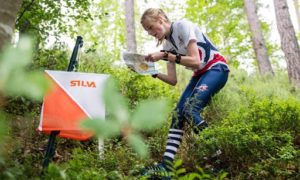Foot Orienteering

Foot Orienteering (referred to as Orienteering or FootO) is an endurance sport in which participants start at staggered intervals over an unmarked route and are expected to perform all navigation on their own with a specially produced map and compass between various checkpoints marked with orange-white lanterns known as controls along an unfamiliar course while running. The map gives detailed information on the terrain such as hills, ground surface, obstacles, etc.
To be successful in foot orienteering, the athlete needs excellent map reading skills, absolute concentration, and the ability to make quick decisions on the best route while running at high speed.
The control points are shown on the orienteering map and must be visited in the specified order. Standings are determined first by successful completion of the course, then by the shortest time on the course.
At each event, there are a variety of courses to suit every level of fitness and ability. The basic map reading and navigational skills are easily learned with instruction available for beginners at all orienteering events.
Orienteering caters to all ability levels and ages.
There is a wide variety of orienteering events: individual competitions and relays, ultra-short park races, and mountain marathon events. Night orienteering with the aid of a headlamp is also a popular form of orienteering.
Foot orienteering became a recognized Olympic sport in 1977
Orienteering Formats
The official formats in the World Orienteering Championships which are followed by most regional and national championships include the following:
-
Long-distance
The long-distance competition, previously called the classic distance competition, is the longest and toughest individual competition. Long competitions are held in the forest, in physically demanding terrain with large-scale route choices and varying scales of technical difficulties.
-
Middle distance
The middle distance competition, previously called the short distance competition, is a relatively shorter race held in the forest, in technically complex terrain.
-
Sprint
Sprint competitions are high-speed competitions held in urban areas, which are technically easy but with difficult route choices.
-
Relay
The relay, composed of teams of 3, is a mass start event where different runners are separated by means of forking. The finish order is directly determined at the finish line.
-
Sprint relay
The sprint relay is run by teams of 4, where the first and the last must be women, in urban areas with mass start and forking.
Orienteering Equipment:
- RACING SUIT: A lightweight, stretchy suit protects from undergrowth whilst allowing maximum freedom of movement even if it gets soaking wet.
- SHOES: Light, strong shoes with non-slip soles allow sure grip on all types of ground – including mud and bare rock.
- MAP: The map provided by the organizer shows the course with the control points which must be visited. The map is designed to give detailed information on the terrain – hills, ground surface, and features such as boulders or cliffs.
- COMPASS: There is a wide variety of sophisticated compasses to choose from. Basically, they can be divided into two main categories: base plate and thumb compasses.
- CONTROL CARD: To prove that they have visited all control points in the right order, the orienteers have to punch their control card at each control using an electronic device.
